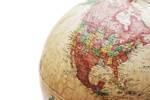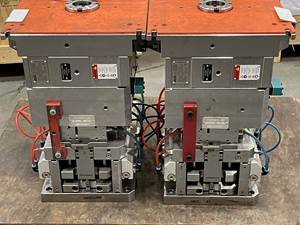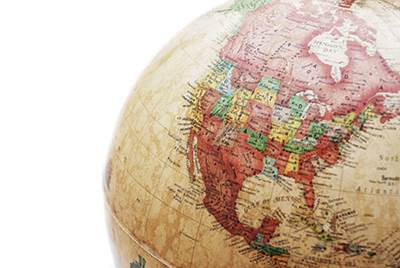Moldmaking Opportunities in Central and South America
In addition to the Asian region, Central and South America represent a high growth area for the U.S. plastics industry.
In addition to the Asian region, Central and South America represent a high growth area for the U.S. plastics industry. In 2013, this region was the destination for $22.2 billion worth of U.S. plastics exports. Only 10 of the 48 countries in the region did not experience positive growth in such exports from 2000 to 2013, and 21 of them (44 percent) actually were among the highest growth export markets for the U.S. plastics industry during that time period. (To qualify for inclusion in this group, a country had to have received at least $25 million in U.S. plastics exports and have experienced an increase of 87 percent or more from 2000 to 2013.)
We examined the Mexican and Canadian markets in March, and will discuss Brazil, Russia, India and China (BRIC) in the August issue. Here we will discuss the top 10 export markets for the U.S. plastics industry after Mexico and Brazil. These countries, based on the total dollar value of U.S. exports shipped, are Colombia, Argentina, Peru, Chile, Costa Rica, the Dominican Republic, Venezuela, Ecuador, Guatemala and Honduras.
Macroeconomic Overview
Central and South America
Central and South America were barely affected by the global financial crisis of 2008-2009. However, after a sustained period of very strong growth, the region is experiencing a moderate economic slowdown, which could become persistent if local governments do not take policy action to increase the growth capacity of their respective economies. Slower growth could result in severe consequences for the countries in the region.
Over the past decade, there was substantial reduction in poverty along with some lessening of economic inequality in Central and South America. In part, these developments have contributed to the emergence of a middle class, posing a challenge to policy makers as this group demands access to efficient and high-quality public services. In addition, this middle class is calling for more and better jobs, and for the introduction of policies to improve productivity.
Although more citizens in the region will be demanding these things from their governments, there will likely be fewer new jobs, smaller pay raises and less budgetary discretion with which to provide more and improved public services and goods.
At this time, the Central and South American region is confronting an international context shaped by lower external demand and more uncertainty surrounding external financial conditions. This is a result of normalization of U.S. monetary policy or an anticipated tapering of the Federal Reserve’s quantitative easing program.
The global economy has entered a period of slower growth. Although it will gradually improve, it is not expected to return to pre-crisis levels. Between 2003 and 2007, the world economy grew by an average of 4.8 percent a year. Today, the International Monetary Fund anticipates an average growth rate of no more than 4.1 percent a year for the next five years. Growth in Central and South America also has suffered from this global slowdown, since economic activity in the region is strongly tied to global business and financial cycles.
Ultimately, economic growth in the region should still fare well compared to previous decades, but the aforementioned global scenario will affect development in Central and South America with a decrease in the volume of foreign trade, a fall in commodity prices and a normalization of financial conditions for obtaining credit.
Ease of Doing Business
The World Bank has developed an index that ranks 189 economies on their ease of doing business. A high ranking on this Ease of Doing Business Index means the regulatory environment is more conducive to the start and operation of a local firm. The index averages the country’s percentile rankings on 10 equally weighted topics, made up of a variety of indicators. Countries are also ranked in each topic.
Although it is not specific to the plastics industry or exclusively regulatory in focus, this index provides an excellent benchmarking tool to assess a country’s general business climate/environment over time and in comparison to other export markets.
The chart below compares the overall Ease of Doing Business rankings and individual indicators for the 10 focus countries. The following findings reflect reforms implemented from June 2012 to June 2013 that affect all sets of indicators among seven of the 10 focus countries that underwent notable changes from last year’s report to the current one.

Chart courtesy of The World Bank.
Argentina
Starting a business in Argentina is difficult because of an increase in incorporation costs. At the same time, the country improved trading across borders by eliminating non-automatic license requirements.
Chile
Starting a business in Chile is easier due to a new online system for business registration.
Colombia
Electricity is easier to get in Colombia because of a one-stop shop for electricity connections and efforts to improve the efficiency of the utility’s internal processes. In addition, Colombia made contract enforcement easier via simplified commercial dispute proceedings.
Costa Rica
Launching a business in Costa Rica is easier through an online business registration platform that reduces social security registration time and simplifies the legalization of company books. The country has also eased the construction permit process by eliminating procedures, improving efficiency and launching an online platform that streamlines the building permit process.
Ecuador
Electricity is easier to get in Ecuador because of new zone divisions in the city of Quito that simplify the handling of applications for new connections. This improved the utility’s customer service and reduced connection fees.
Guatemala
An online platform that permits simultaneous registration of a new company with different government agencies has made starting a business in Guatemala easier. A one-stop shop, backed by institutions and agencies involved in the permitting process, has streamlined procedures for construction permits. In addition, a new electronic filing and payment system has eased the tax payment process.
Venezuela
Starting a business in Venezuela is more costly due to an increase in company registration fees. In contrast, it improved access to credit information by getting financial institutions involved in data collection.
U.S. Plastics Industry Exports
This breakdown shows U.S. plastics exports shipped to each country, ranked highest to lowest total dollar value.
Colombia
From 2000 to 2013, U.S. plastics industry exports to Colombia grew by 254.5 percent from $199.1 million to $705.9 million, and from 2012 to 2013, they increased by 0.3 percent. Plastics imports from Colombia fell 15.4 percent to $132.0 million in 2013, yielding a positive trade surplus of $573.9 million.
U.S. plastics industry exports in 2013 by core segments were:
Resins: $547 million (1.9 percent increase)
Products: $143 million (5.7 percent decrease)
Machinery: $16 million (4.7 percent increase)
Molds: $425,000 (54.1 percent decrease)
Argentina
From 2000 to 2013, U.S. plastics industry exports to Argentina grew by 123.3 percent from $252.5 million to $563.9 million, and from 2012 to 2013, they increased by 0.1 percent. Plastics imports from Argentina dropped 12.6 percent in 2013 to $21.1 million, yielding a positive trade surplus of $542.8 million.
Resins: $441 million (1.3 percent increase)
Products: $111 million (3.6 percent decrease)
Machinery: $10 million (11.3 percent decrease)
Molds: $1 million (170.0 percent increase)
Peru
U.S. plastics industry exports to Peru grew by 390.1 percent from $105.6 million in 2000 to $517.6 million in 2013. From 2012 to 2013, they decreased by 4.6 percent. Plastics imports from Peru grew 2.0 percent last year to $31.8 million, yielding a positive trade surplus of $485.8 million.
Resins: $414 million (10.7 percent decrease)
Products: $96 billion (31.2 percent increase)
Machinery: $7 million (61.7 percent increase)
Molds: $137,000 (87.7 percent decrease)
Chile
From 2000 to 2013, U.S. plastics industry exports to Chile grew by 281.9 percent from $135.3 million to $516.6 million, and from 2012 to 2013, they decreased by 10.7 percent. Plastics imports from Chile rose 2.8 percent in 2013 to $20.4 million, yielding a positive trade surplus of $496.2 million.
Resins: $360 million (8.5 percent decrease)
Products: $132 million (4.2 percent increase)
Machinery: $24 million (58.8 percent decrease)
Molds: $723,000 (16.4 percent increase)
Costa Rica
U.S. plastics industry exports to Costa Rica grew by 165.5 percent from 2000 to 2013, from $165.9 million to $440.5 million. From 2012 to 2013, they increased by 4.3 percent. Plastics imports from Costa Rica also climbed 3.6 percent in 2013 to $107.7
million, yielding a positive trade surplus of $332.8 million.
Resins: $271 million (0.6 percent increase)
Products: $146 million (13.1 percent increase)
Machinery: $20 million (7.7 percent decrease)
Molds: $4 million (37.2 percent increase)
Dominican Republic
From 2000 to 2013, U.S. plastics exports to the Dominican Republic grew by 183.4 percent from $149.9 to $424.9 million, and from 2012 to 2013, they increased by 5.2 percent. Plastics imports from that region grew 4.7 percent last year to $151.9 million, yielding a positive trade surplus of $273.0 million.
Resins: $203 million (5.9 percent increase)
Products: $211 million (2.7 percent increase)
Machinery: $8 million (40.3 percent increase)
Molds: $4 million (125.8 percent increase)
Venezuela
From 2000 to 2013, U.S. plastics industry exports to Venezuela grew by 112.0 percent from $184.7 million to $391.8 million, while they decreased by 6.0 percent from 2012 to 2013. Plastics imports from Venezuela rose 48.4 percent to $4.3 million in 2013, yielding a positive trade surplus of $387.5 million.
Resins: $245 million (5.5 percent increase)
Products: $134 million (8.6 percent decrease)
Machinery: $10 million (65.2 percent decrease)
Molds: $3 million (72.4 percent increase)
Ecuador
U.S. plastics industry exports to Ecuador grew by 315.3 percent from 2000 to 2013, from $66.7 million to $277.1 million. From 2012 to 2013, they increased by 0.1 percent. Imports from Ecuador increased 6.4 percent to $15.8 million in 2013, yielding a positive trade surplus of $261.3 million.
Resins: $224 million (1.4 percent decrease)
Products: $43 million (0.4 percent decrease)
Machinery: $9 million (44.7 percent increase)
Molds: $766,000 (188.9 percent increase)
Guatemala
From 2000 to 2013, U.S. plastics industry exports to Guatemala grew by 139.5 percent from $110.9 million to $265.7 million, and from 2012 to 2013, they increased by 7.5 percent. Plastics imports from Guatemala fell 5.3 percent to $14.3 million in 2013, yielding a positive trade surplus of $251.4 million.
Resins: $202 million (9.0 percent increase)
Products: $61 million (3.3 percent increase)
Machinery: $3 million (2.6 percent decrease)
Molds: $77,000 (27.6 percent increase)
Honduras
Finally, exports to Honduras grew by 98.4 percent from 2000 to 2013, from $90.8 million to $180.2 million. They increased by 9.1 percent from 2012 to 2013, while plastics imports from Honduras decreased 6.8 percent to $14.3 million last year, yielding a positive trade surplus of $165.9 million.
Resins: $81 million (2.7 percent increase)
Products: $97 million (15.3 percent increase)
Machinery: $2 million (4.8 percent decrease)
Molds: $651,000 (22.0 percent increase)
Export Opportunities for Moldmakers
Evaluating the Central and South America region revealed growth opportunities for the U.S. plastics industry and for moldmakers in particular. The country breakdowns presented here indicate that seven of the 10 markets are attractive for moldmakers. The table below shows the percentage increases in U.S. mold exports from 2012 to 2013 (ranked from highest to lowest).

Table courtesy of SPI.
These markets differ not only in their total dollar export amounts, but in their volatility as well. Volatility refers to significant ups and downs in total dollars being exported from year to year. A look at mold types being exported from 2000 to 2013 shows great volatility. This market analysis identifies Costa Rica, the Dominican Republic and Ecuador as key growth areas for U.S. moldmakers. It also identifies compression and non-injection/compression molds as mold types with the most growth. Costa Rica and the Dominican Republic stand out with 25.6 and 217.1 percent increases, respectively, in compression mold exports from 2012 to 2013. The Dominican Republic and Ecuador also stand out with 86.5 and 201.7 percent increases, respectively, in non-injection/compression mold exports for the year. All three of these countries did not exhibit a high degree of market volatility.
Related Content
Mold Innovations Power Unique Auto Lighting Elements on Hummer EVs
Diamond machining, electroforming of micro-optical inserts and modified latch-lock system help injection molds produce unique forward lighting elements.
Read MoreWhat Electric Vehicles Mean to Mold Builders
Harbour Results CEO Laurie Harbour on why EVs make the situation at mold and tool shops more challenging.
Read MoreHarbour Results, AutoForecast Solutions Release Battery-Electric Vehicle Market Study
The study analyzes the transition from an industry dominated by the internal combustion engine to battery-electric mobility and its impact on the supply chain, which will have ripple effects from automakers to tool and die shops.
Read MoreSpecialist Automotive Mold Builder Mentors in Work and Life Skills
Southeastern mold builder PFAFF Molds sets the standard in toolmaking for automotive window and vehicle body sealing systems through knowledge-sharing and automation.
Read MoreRead Next
Moldmaking Opportunities in NAFTA Markets
North America contains the two largest trading partners for the U.S. plastics industry—Mexico and Canada. In 2012, these two countries were the destination for $13.6 billion and $12.5 billion worth of U.S. plastics industry exports, respectively. Combined, this represented 31 percent of total U.S. plastics industry exports in 2012.
Read MoreHow to Use Strategic Planning Tools, Data to Manage the Human Side of Business
Q&A with Marion Wells, MMT EAB member and founder of Human Asset Management.
Read MoreAre You a Moldmaker Considering 3D Printing? Consider the 3D Printing Workshop at NPE2024
Presentations will cover 3D printing for mold tooling, material innovation, product development, bridge production and full-scale, high-volume additive manufacturing.
Read More





















